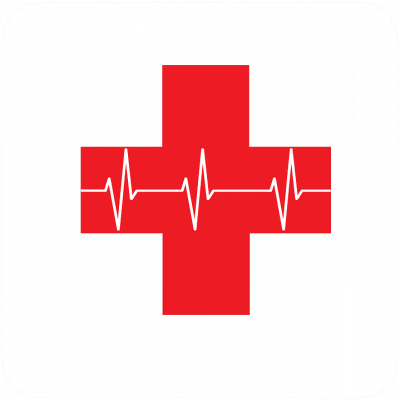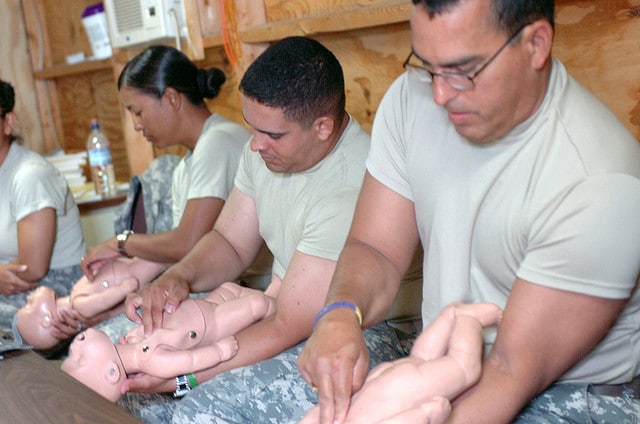
Cuts. Bruises. Fevers, chills, choking.
These words might make you think of an emergency room, but there is one other place these afflictions can haunt you: your home. Your home is where the heart is, but it is also where accidents, tears, and panic can be.
Whether you decide to turn to a hospital or not in the case of an emergency, it is important to know basic first aid. Knowledge will help you respond calmly and efficiently to an injury or sickness–and it could be enough to save a life.
Each case is different, so this is not an exhaustive list of medical reactions or a substitute for professional care. But here are some helpful tips to knowing if you need a hospital visit and how to cafe for a hurt or sick child showing some common afflictions.
Table of Contents
Cuts
Know about cuts so you can address and treat them to prevent infection. Rob Brouhard from abouthealth.com gives some guidelines for how to know if a cut needs stitches.
Stitches close open wounds and prevent infection and scarring. A deep cut that reveals a yellow, fatty tissue (or subcutaneous tissue) may need stitches. Typically, if you cannot pinch closed a cut, it will need stitches. Remember to apply pressure on a wound to help stop the bleeding in all cases, especially until you reach professional help.
Always clean a cut and keep it clean while dressing it or waiting for professional attention. Wash the depth of the wound and the surface with soap and water. Rinse soap away thoroughly. Repeat the cleaning if the wound or dressing becomes dirty.
Use ointment on cuts that have stopped bleeding to prevent germs from entering the cut. Keep a variety of bandages on hand for different wounds. Simple band-aids go a long way toward calming down your child and helping the wound heal. Use gauze for larger wounds or wounds that hair covers. Don’t dress an infected or contaminated wound.
Burns
Brouhard also wrote an article about burns, including a gallery of different burns, which explains how to identify the different degrees. First degree burns are red. Second degree burns develop blisters.
Run burns under cool water for several minutes. Apply burn ointment to alleviate the pain and use ibuprofen for pain if you need to. Never pop blisters.
Third degree burns are harder to identify, but if the injury is blistering, black, larger than your chest, or deep enough to burn through your skin and show tissue, it might be a third degree burn that needs medical attention. You might not be able to diagnose a burn as a third-degree burn, but use your good judgment. If the burn is deep and larger than what you’re comfortable dealing with, seek professional help.
Never use butter to cool down burns. The oils in the butter will trap heat and make it worse.
Never ice a burn either—it can cause frostbite to an already damaged and sensitive injury. Also, always keep victims hydrated and watch for signs of shock.
Call 911 for severe burns, burns that wrap around an arm or a leg, or burns on sensitive areas like genitals or the face. Seek professional help for burn victims who are dizzy, confused, chilled, fevered, or in shock.
Choking
You should also know how to help a choking infant. If a baby or child cannot cough or cry, or if he or she has difficulty coughing, they might be choking. Have someone call 911 while you start helping the victim. Quick responses could save a life.
First give a choking baby five blows to the back. Secure the infant by holding it facedown on your arm or leg, with the head lower than the bottom. This positioning will help the choking hazard come down and out of the airway when you are giving the back blows. Strike the baby with the heel of your hand in between the shoulder blades up to five times.
If the baby is still choking after the five back blows, turn him or her around for five chest thrusts. Keep the head lower than the bottom again. Use two fingers in between the nipples to push down about an inch. Repeat five times or until the baby coughs up the object.
If neither tactic works, make sure someone has called 911. Keep trying until help comes. See nurse Sarah Hunstead’s choking child or baby video for a visual.
Also learn infant CPR for an unconscious baby and the Heimlich Maneuver for adults and children more than a year old.
Bloody Nose
Bloody noses are common with children who pick their noses or who experience trauma to the face. In any case, have your child lean forward, not back, to avoid the blood leaking into the stomach. Stop blood flow by pinching just below the bony bridge of the nose. Hold for five minutes, then check to see if it has stopped bleeding. If it hasn’t, pinch the nose again, this time for 10 minutes.
See a doctor or call 911 if the nose won’t stop bleeding or if the victim gets dizzy or weak.
Sprains and Breaks
Learn how to wrap common sprains, like an ankle sprain. You generally need to wrap ankles loosely with a bandage starting at the top of the ankle. Keep the foot at a right angle to prevent the foot from going back to the sprained position. Make the bandage more tight as you wrap down and under the foot. Continue wrapping under and around the foot and ankle until you reach the toes. Ask professionals for more help, practice, or advice on ankle wrapping.
Get immediate medical attention if someone has broken or fractured a bone. Be aware of signs of shock, such as paleness, cold sweat, lightheadedness, or confusion. Be careful to not apply pressure over the break, but gently apply pressure to a wound to stop bleeding. Using a towel-wrapped ice pack can help numb the pain and reduce swelling.
Learn how to make a splint in the position you found the break in, but only splint if you don’t have immediate access to professional help.
General information
One of Good Guys Injury Law’ free books, “The Utah Bicycle Accident Handbook,” offers general first aid tips for when you are at the scene of an accident. Remembering the ABCDE guidelines can help you prepare a victim of an accident for an ambulance’s arrival.
Make sure a victim’s airway is clear by tilting the head and checking for objects in the mouth. To check a victim’s breathing put your ear near their nose and mouth and feel for their breath. Check blood circulation by looking for pools of blood; tend to injuries with heaviest bleeding first. Check the head and neck for injuries to the spinal cord, which could lead to disability. Keep the victim safe from exposure to harsh environments until medical help can come.
A lot can happen in and outside a home. We have covered a few tips on basic first aid, but do not be afraid to ask for professional help if you are unsure of what you should do. Keep your resources close in case of an emergency. Know the number for the Poison Control Center (800-222-1222). Call your doctor for advice or treatment. Prepare yourself by knowing the basics. That knowledge can be critical in helping you and your child stay calm and safe while medical help is on the way.
Image courtesy of Pixabay
